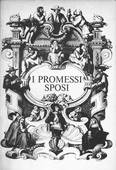Welcome to the course website for Italian 480: Studies in Italian Literature: Manzoni in the Digital Age. This course is taught at the University of Kansas in the Department of French & Italian with the support of the Institute for Digital Research in the Humanities and the Ermal Garinger Academic Resource Center.
I Promessi sposi (1827)

Manzoni’s 700-page novel is the story of a young man, Renzo, who must complete an arduous journey through plague-stricken, war-torn northern Italy in order to be able to marry his betrothed, Lucia. Their desire for marriage is blocked by judicial, religious, and political figures throughout the novel. Like many authors, Manzoni chose a historical setting in order to comment on his own era. The Betrothed lends itself to parallel readings of Manzoni’s fictionalized seventeenth century setting and the history of the early nineteenth century in Italy. Traditional instruction of the book focuses on power struggles, socio-economic changes, and the spirituality of the characters. The plot, narrative elements, linguistic styles, and thematic content also lend themselves to study and analysis using tools available to digital humanists.
